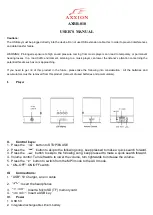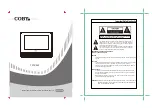
6
Generac
®
Power Systems, Inc.
1.8
AUTOMATIC SYSTEM OPERATION
When this generator, along with its transfer switch, has
been installed and interconnected, a circuit board in
the generator panel constantly monitors UTILITY
power source voltage. Should that voltage drop below
a preset value, and remain at such a low state for a
preset amount of time, the generator cranks and
starts. After the generator starts, the transfer switch
transfers LOAD circuits so the generator can power
them.
When UTILITY source voltage has been restored, the
switch re-transfers back to the UTILITY source volt-
age and the generator then shuts down.
1.9
GENERATOR AC CONNECTION
SYSTEMS
The generator was shipped from the factory with its
stator AC output leads connected in a single-phase,
three-wire generator AC connection system (Figure
1.3). The stator assembly in this system consists of a
pair of stationary windings, with two leads brought
out of each winding. Each single winding can supply
120 VAC, 60 Hertz. When the two windings are con-
nected in series, a 240 volts, 60 Hertz AC output
results. Typically the two “hot” leads in the circuit are
Wires 11 and 44. The “Neutral” leads are the junction
of Wires 22 and 33.
Figure 1.3 - Generator AC Connection System
1.10 MAIN CIRCUIT BREAKER
The generator’s main circuit breaker is included with
the unit as shipped from the factory. The breaker for
each unit is described in Figure 1.4.
1.11 GENERATOR FUEL SYSTEM
The unit has been factory tested and adjusted using
a natural gas liquid fuel system. If LP vapor gas is
preferred, contact an authorized service dealer. Refer
to Section 1.17.
Recommended fuels should have a Btu content of at
least 1,000 Btus per cubic foot for natural gas or at
least 2,520 Btus per cubic foot for LP gas. Ask the
fuel supplier for the Btu content of the fuel.
Fuel pressure for both natural gas and liquid
propane set ups should be
11 inches to 14 inches
of water column (0.6 psi)
at all load ranges.
NOTE:
A separate gas line and regulator is needed to
assure proper gas pressure (11-14”) to the genera-
tor. Low gas pressure can cause hard starting and
could affect engine durability.
Gaseous fuels such as natural and LP
(propane) gas are highly explosive. Even the
slightest spark can ignite such fuels and cause
an explosion. No leakage of fuel is permitted.
Natural gas, which is lighter than air, tends to
collect in high areas. LP gas is heavier than air
and tends to settle in low areas.
1.12 ENGINE PROTECTIVE DEVICES
The engine has several safety switches which cause
the engine to automatically shut down under the fol-
lowing conditions: low oil pressure, high coolant tem-
perature, engine overspeed, low coolant level or over-
crank (Figure 1.5).
Figure 1.5 - Engine Protective Devices
!
Section 1 — General Information
Generac Liquid-cooled 20 kW Generator
Model
Rating
Phase
Actual Current
C/B Rating*
Circuit Breaker
4920-0
20,000 Watts
1
83.3 Amps
90 Amp
90A BQ2
* Amp Rating of C/B structured under model.
Figure 1.4 - Main Circuit Breaker









































